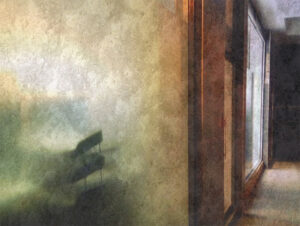Stephen Payne reviews House on the A34 by Philip Hancock (CB Editions, 2023)
I should declare some history. I reviewed Philip Hancock’s first poetry pamphlet Hearing Ourselves Think (Smiths Knoll, 2009), and followed him onto the Smiths Knoll mentorship scheme.
I’m pleased to report that much of what I admired about that pamphlet holds true of this, his second full collection with CB Editions. Hancock’s poems are mostly set in the world of skilled manual labour, in particular painting and decorating. Hancock evidently worked in a team contracted by the council to decorate flats and schools and municipal buildings. Probably ‘team’ is the wrong word – perhaps it should be ‘crew’ or ‘gang’? Hancock would know, of course, and that’s one of the strengths of this collection. We’ve all done a bit of painting and decorating, I suppose. Many of us have employed professionals to refresh our homes. Much of the paraphernalia and some of the sights and smells and strategies are familiar. A pleasure, then, to read about these, vividly and authentically described, to immerse ourselves in this professional world and its vocabulary, and to gain a professional’s perspective, the “sediment / of turpentine and paint skins”, the “lengths of inch and a half / by a quarter”, the “cleat hooks” and the “galvanised conduits / and trunking”. Alongside the physical stuff, there’s the human relations, the bosses and mates, including the banter. It’s good to meet The Do Ron Ron, Big Ribs, and Filthy Wilfy, and to learn about ‘The Caretaker’s Mug’.
Beyond the consistent frame of painting and decorating, individual poems provoke wider reflections on economic and psychological life. Subtly, I would say, and in a uniform, plain and natural style, but with style nonetheless.
Beyond the consistent frame of painting and decorating, individual poems provoke wider reflections on economic and psychological life
In terms of form, I think all the poems are in free verse (except ‘Contract Colours’ and ‘Works Do’ which are in prose paragraphs), and most are arranged in stanzas of equal length. The stanzas are usually end-stopped. The typical line is short, three or four stressed syllables, and line length is consistent within-poem. The lines usually end at phrase boundaries. All this plain regularity allows the occasional exception to stand out, and to be used to some effect.
For example, in ‘Pips and Stripes’, the author is working at a police station, his efforts inspected by the Deputy Chief Constable:
The silence of corridors.
Any door that went: which shoes
were his? Nothing escaped his eye.
The line-break “shoes / were his” reflects the time-course of the attempt at identification.
Similarly, ‘Getting to the top’, is about working in a tower-block which has no lift:
You start off two stairs at a time.
By the fourth trip you’re counting
the eleven per rise, the two rises
to every floor. Coming down
you remember which floor
by what framed prints on each landing.
The between-stanza enjambment hints at the structure of the climbed staircase, a pause for breath or an increment of the mental tally.
In ‘Man on the Fire Escape’, the only short line accentuates the drama of the imagined moment:
Next time you’re passing,
his arm’s locked round a stanchion,
leaning out, full stretch.
One slip
and he’s through your windscreen.
Small things. Details. Not what matters most about the poems. But handled with care and satisfying for this reader. And absolutely in keeping with the ethos of the proud, conscientious painter-decorator, as made clear by ‘Lid’, one of the shortest poems, which captures Hancocks’s values, both of content and style:
The job’s to lever it open,
get straight on with what’s in the tin.
But what clings to its underside
[…]
could make the difference.
So much depends on the smear of paint. It might finish off the topcoat of the wheelbarrow. Hancock has a poem called ‘Wheelbarrow’ too. It’s about the paradox of putting-off, the danger of manãna. Don’t we all make work for ourselves like this?
Ten minutes would have been plenty
to scrape out the last of yesterday’s mix
[…]
Now I’m bent over the bed,
wielding a lump-hammer instead
Interspersed among the poems about work and the characters in the firm are poems about home life and school. Walking through town, Hancock hears a school playground during ‘Breaktime’, “a high-pitched din, / screams piercing its ongoing”. The unseen screams are emotionally ambiguous, and provoke memories of “learning to survive” and “hoping for a whistle or bell.”
Interspersed among the poems about work and the characters in the firm are poems about home life and school
But Hancock’s never really off the job. Indeed, there’s a poem called ‘Bringing the Job Home’ in which his expert eye can’t help but notice the decorative state of his own toilet door, “that panel pin / waggled loose in the beading strip”. And in ‘Autobiography’, when he looks for a metaphor for what is constant in his life or self, he finds a crack in the ceiling above his bed: “Hard to gauge any advance / on yesterday, or last year.” He realises that there’s some comfort in such stability: “Even where someone’s / made good with filler / it opens again.”
As ever, CB Editions has done a splendid job on production. I will mention in particular the back-cover blurbs, by Will Eaves and Declan Ryan, which are insightful and cliché-free.
Stephen Payne is Professor Emeritus at the University of Bath, where until September 2020 he taught and conducted research in Cognitive Science. He lives in Penarth in the Vale of Glamorgan. His first full-length poetry collection, Pattern Beyond Chance, was published by HappenStance Press in 2015 and shortlisted for Wales Book of the Year. His second collection, The Windmill Proof (2021), and a pamphlet The Wax Argument & Other Thought Experiments (2022) were published by the same press.

